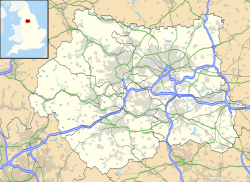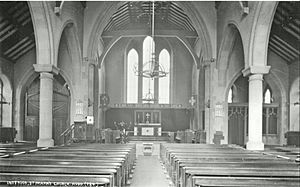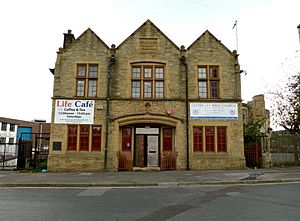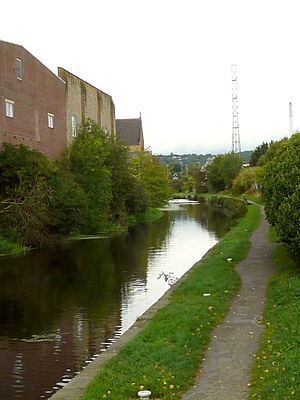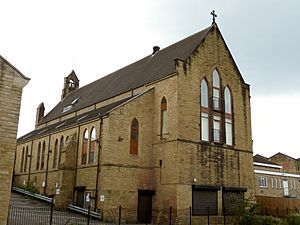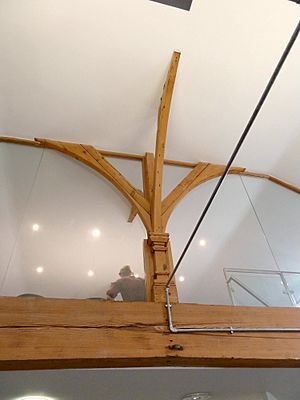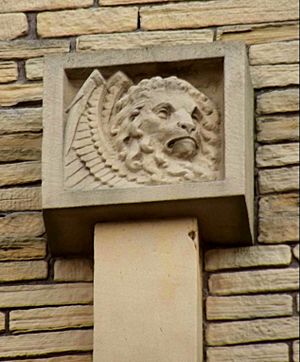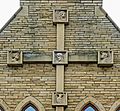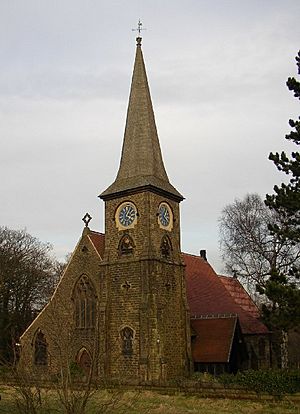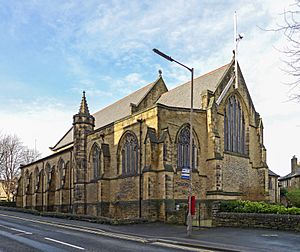St Mark's Church, Huddersfield facts for kids
Quick facts for kids Church of St Mark, Old Leeds Road |
|
|---|---|
| Former Church of St Mark, Old Leeds Road, Huddersfield | |
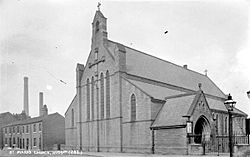
St Mark's, before 1907
|
|
| 53°38′58″N 1°46′35″W / 53.64944°N 1.77639°W | |
| OS grid reference | SE148170 |
| Location | Huddersfield, West Yorkshire |
| Country | England |
| Denomination | Church of England |
| Churchmanship | Central |
| History | |
| Status | former church |
| Founded | 15 May 1886 |
| Dedication | Mark the Evangelist |
| Dedicated | 27 September 1887 |
| Consecrated | 27 September 1887 |
| Architecture | |
| Functional status | Defunct |
| Heritage designation | Unlisted |
| Architect(s) | William Swinden Barber |
| Architectural type | Mission church |
| Style | Gothic Revival architecture |
| Specifications | |
| Bells | 1 |
| Administration | |
| Parish | Formerly St Mark's, Huddersfield |
The former St Mark's Church on Old Leeds Road in Huddersfield, West Yorkshire, England, was once an Anglican parish church. It was also known as St Mark's, Leeds Road, before the road name changed. This helped tell it apart from another St Mark's church in Longwood, Huddersfield.
The church building was designed in 1886 by William Swinden Barber. It was needed because the local church area, called a parish, was growing. The main church, St Peter's, was getting too crowded. St Mark's Church opened its doors in 1887. Over the years, several interesting vicars served there. These included Canon Percy Holbrook, who was very popular, and Reverend Joseph Miller, a skilled speaker. The Church of England sold the building in 2001. Today, it has been changed into a block of offices.
Contents
Laying the Foundation Stone
The first stone of the church, called the cornerstone, was laid on Saturday, May 15, 1886. Even though the weather had been bad, a large crowd gathered under a big tent for the ceremony.
A special silver trowel with an ivory handle was used. It was given to Mrs. William Brooke, who laid the stone. The trowel had an engraving that listed the architect, vicar, and others involved. A beautiful rosewood mallet was also used, given by William Henry Jessop.
Many important people attended the event. These included Mr. William Brooke and his wife, along with many church leaders and the choir. The headmaster of Huddersfield College and local officials were also there.
The people sang a hymn, This stone to thee in faith we lay. Reverend J.W. Bardsley gave a speech. He explained that many people had moved to cities during the Industrial Revolution. This meant that city churches became very full. He said that Huddersfield's main church only had 500 free seats, but the population was much larger. This was why St Mark's was being built. The land for the church was given by Sir John Ramsden.
Rev. Bardsley also mentioned that even poorer people had helped raise money for the church. He asked the community to keep raising funds for the rest of the building work. Another hymn, Christ is our corner stone, was sung. The collection that day raised £42 1s 1d. The treasurer said they had promises of about £4,800 but needed £6,000 in total.
A time capsule was placed inside the cornerstone. It was a bottle containing copies of newspapers from that day, current coins, and a description of the church with the names of the builders. After Mrs. Brooke laid the stone, the crowd cheered. The event ended with the National Anthem and a prayer.
Church Opening Ceremony
The church building was officially opened, or consecrated, on Tuesday, September 27, 1887. A large group of people gathered at 10:30 AM. The ceremony was led by William Boyd Carpenter, the Bishop of Ripon.
The Bishop walked in a procession up the middle of the church with many other church leaders. There were 33 clerics in total, including the Bishop and the vicar of St Mark's, Rev. J. Dunbar. Thirteen members of the building committee also joined the procession.
After everyone was seated, a special document about the church's land was read and signed by the Bishop. Then, the Bishop led the consecration prayers. A morning service followed, with prayers, readings, and a communion service. The choir and organist from the main Parish Church helped with the music. They sang several Psalms and hymns like Christ is our corner stone.
The Bishop's sermon was about looking beyond what we can see, focusing on things that are eternal. He spoke about life after death and Jesus' work with the poor. This message was important for the local people, many of whom were very poor and had not had many chances to attend church. The collection during this service raised £201 4s 11d.
After the service, a large lunch was held at the Parish Church Schools. Many church leaders and local people attended. During the speeches, it was noted that 1887 was the year of Victoria's Golden Jubilee. It was also mentioned that people from different Christian groups had helped fund St Mark's.
The estimated cost of the building was £4,024, but they had raised over £5,430, including money from very poor local people. The architect, William Swinden Barber, was praised. He said the church was "extremely plain" and could be improved with stained glass later. It was also suggested that a new church school should be built nearby, and a house for the vicar. These were built later. Even after the lunch, many people came to the evening service, which raised another £11 9s.
Church Design
The church was designed to be simple because there wasn't much money, but a large number of people needed a place to worship. It was built in a "mission-church" style, which means it was plain and didn't have a high central section with windows (called a clerestory).
The building took up almost all the available land from west to east, leaving only a small space between it and the Huddersfield Broad Canal. The front of the church, facing Leeds Road, was described as simple but striking. It had a central support, or buttress, separating two tall windows. A large stone cross was built into the wall above this. This cross was meant to have carvings of symbols for the evangelists (Mark, Matthew, Luke, John). By 1887, the cross had an image of a suffering Jesus, and a bell made by Mears & Stainbank was in the bell tower.
Because the church was so close to the canal, the foundations for the east wall had to be very deep and made of concrete. The canal company even had to drain the canal water twice while the church's groundwork was being done.
Inside the Church
The original plans for the church showed a main area, called a nave, that was about 63 feet (19 meters) long and 26 feet (8 meters) wide. The chancel, where the altar is, was about 23.5 feet (7 meters) long and 26 feet (8 meters) wide. There were also side areas, called aisles, and a porch.
At the east end of the north aisle, next to the chancel, there was a space for the organ. Below the chancel and the east ends of the aisles were "spacious vestries" (rooms for clergy) and a heating room. These lower rooms were possible because the ground sloped downwards, so the chancel above was raised by seven steps.
The plans for the inside mentioned that the roofs and the arch leading to the chancel would be impressive due to their wide span and heavy wooden beams. The windows and open benches were designed to be very plain. The east window was planned to have three tall, narrow windows, which would have been a good place for stained glass. However, because the area was poor, stained glass was never added. The church was designed to seat 422 adults and 112 children. By the time it opened, it could seat 500 adults.
The cost of building was estimated at £3,250 in 1886. Different companies handled the various parts of the construction, such as masonry, carpentry, plumbing, and painting. The heating system was also installed.
The wooden roofs inside the nave and chancel were described as "waggon-headed" in 1887. This means the ceiling above the wooden supports was shaped like a round arch, similar to the cover of a wagon. This type of roof was thought to make the sound inside the church very clear. In 1887, the church also had a font (for baptisms), a carved wooden pulpit (for sermons), and a brass lectern (for reading).
The Architect
The architect, William Swinden Barber, lived nearby in Halifax. This meant he could oversee the entire building project closely. Because there wasn't much money and a large congregation needed a place to worship, his main goal was to design a "Mission Church on a large scale." This meant the church had to be very stable but with "exceedingly plain" details. The pews inside were also designed to be very strong.
Church History
St Mark's Church stopped holding services and was officially closed by the Church of England on November 1, 1997. After that, it was rented out to the Huddersfield Sea Cadet Corps. They are remembered for putting a large cutout of a ship across the east window!
Later, an office equipment company rented the building to sell used office furniture. On September 18, 2001, the church was sold to Church Property Holdings Limited. This company kept the original stone carvings and the main roof timbers. They then divided the building into offices, which are now rented out to different businesses.
Sculptures at St Mark's
Church Leaders
Reverend John Dunbar (1887–1888)
Reverend John Dunbar (1856–1925) was the first vicar of St Mark's. He was born in Liverpool in 1856. He studied at St Aidan's College, Durham and became a deacon in 1880 and a priest in 1881.
Before coming to St Mark's, he was a curate (an assistant priest) at St Peter's Church in Huddersfield from 1884 to 1887. The vicar of St Peter's praised Dunbar's work, saying he preached "simple, faithful, gospel sermons" and was good at connecting with people.
Dunbar became the vicar of St Mark's, Leeds Road, on December 21, 1887. He served there until November 1888. During his time, a large bazaar (a fundraising event) was held in the Town Hall. It raised £1,400 to help support the church. This bazaar was one of his last contributions to St Mark's.
He then moved to St Stephen's Church in Rashcliffe, Huddersfield, where he served for many years. He later became the vicar of Helme, Meltham. He passed away in 1925 at the age of 68.
Canon Percy Holbrook (1888–1891)
Percy Holbrook Canon Percy Holbrook (1859–1946) was born in Reading, Berkshire, England. He was the vicar of St Mark's from 1888 to 1891. He later became a well-known church leader in Nottingham.
People described him as having "original ideas" and being brave enough to share them. He was loved by many people in his church and community. He was known as a great speaker, a wise advisor, and a kind friend. He also supported many church and charity groups.
Reverend Thomas Killam-Killam (1891–1897)
Reverend Thomas Killam-Killam (1860–1938) was born in Cowick, near Hull. He studied at Pembroke College, Oxford and became a deacon in 1883 and a priest in 1885.
He was a curate at St Stephen's Rashcliffe, Huddersfield, before becoming the vicar of St Mark's from 1892 to 1897. In 1897, he was offered the chance to lead the new parish of St Barnabas, Crosland Moor, Huddersfield. He served as vicar there from 1897 until he retired in 1934, completing 50 years as a priest.
He married Mary Morse Davies in 1928 when he was 70 years old. He passed away in 1938 at the age of 80.
Reverend Robert Alfred Humble (1897–1901)
Robert Alfred Humble Reverend Robert Alfred Humble (1864–1929) was an Anglican priest born in Durham, England. He was known for his dedication to helping his community. He organized fundraising events and meals for older people. He was also involved in local committees and social events, even playing on his church's cricket team.
He was the vicar of St Mark's from 1897 to 1901.
Reverend James Sowter (1901–1905)
Reverend James Sowter (1855–1917) was born in Norwich in 1855. He became a deacon in 1884 and a priest in 1885. He served in several churches before coming to St Mark's.
He became the vicar of St Mark's in December 1901 and stayed until 1905. He later became the rector of Steeple Gidding and then the vicar of Holme, where he served until his death. He passed away in 1917 at the age of 62.
Reverend Jonas Pilling (1905–1921)
Jonas Pilling Reverend Jonas Pilling (1855–1926) was the vicar of St Mark's from 1905 to 1921.
Reverend Joseph Miller (1929–1931)
Joseph Miller (priest) Reverend Joseph Miller (born 1874) was a Congregational minister who was well-known for his powerful speeches. He was often asked to preach in northern England. While working in Hamburg, he helped his fellow countrymen who were in trouble.
In 1929, he made a big change by becoming an Anglican priest. His first role as an Anglican priest was as the vicar of St Mark's Church, where he served from 1929 to 1931.


